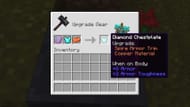Introduced in Minecraft 1.14, smithing tables are intriguing blocks that allow players to upgrade their diamond gear to netherite while functioning as job site blocks for toolsmith villagers. However, these blocks will serve an expanded purpose in update 1.20.
Thanks to Mojang's release of Java Edition snapshot 23w04a, Minecraft players can now utilize smithing tables to not only upgrade diamond gear into netherite, but also add trim to armor for customization.
Additionally, the snapshot changed the basic formula for upgrading diamond gear into netherite. While these features are currently only present in the 23w04a snapshot, Mojang wants to implement these features in update 1.20.
Chart New Territories with the ultimate Minecraft Seed Generator!
Since this is the case, it's a good idea to re-examine the smithing table's functions in Minecraft when it finally receives its facelift.
Using each smithing table function in Minecraft Snapshot 23w04a and update 1.20

Though smithing tables are certainly changing in Minecraft 1.20, they aren't doing so in a massive way. The most notable change is the introduction of smithing templates, items that can be looted from various generated structures.
As of snapshot 23w04a, there are 12 templates, with 11 existing for armor trimming and one for upgrading diamond gear to netherite quality. However, Mojang may see fit to expand the smithing table's features in the future.
Using a smithing table as of Minecraft 23w04a
- The first order of business is to find or craft a smithing table. These tables naturally generate within toolsmith houses in villages. Otherwise, players can create them by combining two iron ingots and four wooden plank blocks on a crafting table.
- Place the smithing table and interact with it. The new UI is relatively the same as the original, but you'll notice more slots than before. The three slots to the left are outlined for smithing templates, gear pieces, and materials. The rightmost slot is for output, allowing you to collect your new items after they've been forged.
- To use a smithing template on a piece of gear (like armor, for example), place your template in the leftmost slot, then your gear piece in the center. If you're using a smithing template for armor trimming, you'll also need to place the appropriate material in the right slot to dictate the color of your new trim. Options include diamonds, gold/iron/netherite ingots, emeralds, redstone dust, lapis lazuli, and more. However, these materials aren't needed if you aren't trimming armor.
- For netherite upgrades specifically, you'll need to place the upgrade template in the leftmost slot, a diamond piece of gear in the center, and a netherite ingot in the material slot.
- Once the materials and gear have been combined, removed your newfound gear from the output slot on the right.
That's all there is to it. While smithing tables may continue to evolve in sequential Minecraft updates depending on Mojang's plans, these are the primary functions of the smithing table.
Keep in mind that the presence of the table also allows villagers without a job to claim it, letting them become toolsmiths, which can be helpful if a player is building an improved village or a trading hall.
Uncover new worlds with our Minecraft Seed Generator!
